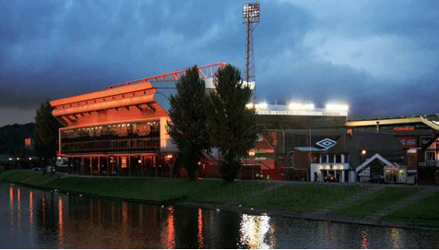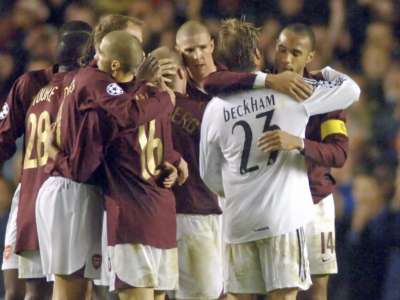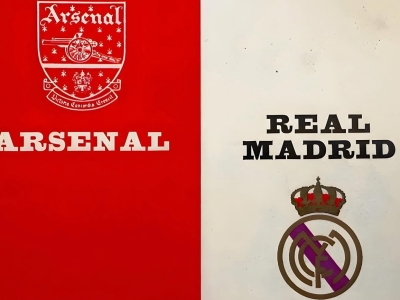Nottingham Forest were founded in 1865 as Nottingham Forest Football and Bandy Club (the latter a form of the Gaelic sport of Shinty, but played on ice). Their name derives from the fact that their original home ground was the Forest Recreation Ground in Nottingham – so called because it was a part of the famed Sherwood Forest of Robin Hood notoriety. As is well known, Nottingham Forest played a pivotal part in the history of Arsenal Football Club as two of the club’s Nottingham born founding fathers – Fred Beardsley and Morris Bates – formerly played for Forest during the club’s amateur days.
Both moved South to take up work in the armaments factory in Woolwich (allegedly, Beardsley lost his job in Nottingham as a result of taking time from work to play for Forest), both also wished to carry on their pastime in a mainly Rugby playing area and hence helped to found the club along with several Scots such as David Danskin and a fellow called Jack Humble who walked five hundred miles from his home village in the North East to Woolwich to find work. Bates and Beardsley wrote to Forest to request if their old club could donate a set of football kits, of which they duly obliged (as a result, Arsenal’s first colours have been red ever since).
Fred Beardsley left Arsenal in 1910, after Henry Norris wound up the original club and formed another in its place. He then joined the board at Charlton in 1913 and run a tobacconists in Woolwich until his death in 1939 at the age of eighty two. His fellow co-founder Morris Bates however, after captaining Arsenal’s first two trophy wins – the Kent Senior Cup and London Charity Cup in 1890 - retired from playing at the age of thirty six and drifted from the game altogether. Sadly, Bates - who carried on Working at the Royal Arsenal in Woolwich - died from Tuberculosis at the age of just forty one.
Their former club Nottingham Forest remained amateur until they became founder members of the Football Alliance League in 1889 and in their final season within that League in 1891/92 won the title. That same year, the Football Alliance merged with the Football League and Nottingham Forest were elected to the First Division of the Football League. Forest’s first stint in the top tier lasted thirteen years and during that time won their first FA Cup by beating local rivals Derby County 3-1 at the Crystal Palace in a game where the Forresters played with ten men as a result of losing a player to injury in a time before the use of substitutes (it would however be Forest’s last trophy win for sixty one years).
That same year, Forest moved to their current home at the City Ground, after stints at Trent Bridge Cricket Ground and a purpose built home called the ‘Town Ground’ which was host to the first recorded instance of a crossbar and goal nets used in a football match. Their new home was just three hundred yards from rival club Notts County across the River Trent (the closest two grounds within the English League, though only a matter of yards separate the stadiums of Dundee and Dundee United). The City Ground is also around one hundred yards from their former home of Trent Bridge Cricket Ground, which is surely the closest distance between three major sports venues outside of an Olympic village.
Arsenal’s first meeting with Forest occurred in the old First Division in October 1904 at the Manor Ground in Plumstead, where Forest inflicted a thumping 0-3 defeat on the Gunners. A couple of months on, Arsenal’s first visit to the City Ground on the day after Boxing Day ended in a 3-0 win for the Gunners with goals from Thomas Briercliffe, Charlie Satterthwaite and John ‘Sailor’ Hunter. Forest remained in the top tier until finishing second from bottom in 1906/07, but returned after one season before dropping again in 1910/11 and remaining in the second tier for the next thirteen years. Arsenal however joined them after suffering relegation in 1912/13. The Gunners’ last meeting with Forest outside of the top tier in April 1915 would also be Forest’s first visit to Highbury. The Gunners ran out 7-0 winners with four goals for Henry King, in front of a crowd of just 10,000.
Nottingham Forest returned to the top flight as Second tier champions in 1921/22 and remained there for three seasons, but after finishing one place above the relegation zone in 1922/23 and 1923/24 the Forresters finished rock bottom in 1924/25 and didn’t return back to the old First Division until after the Second World War. The earliest footage of a Nottingham Forest game available on the internet’s video sharing sites is a silent Pathe News piece on Forest’s visit to Southend United in the fifth round of the FA Cup in 1926. Anyone familiar with London’s nearest major seaside resort will note that this was during a period where the Shrimpers played their home games on the grounds of the famous Kursaal amusement park, with various fairground rides visible in the background. On the day, Forest ran out 1-0 winners.
After twenty four years in the second tier, Nottingham Forest slipped down into the old Third Division South after finishing second from bottom in 1948/49, though came back up to the old Division Two as Champions in 1950/51 and then back to the top tier again as Division Two runners up in 1956/57. In their first meeting with Arsenal for thirty three years, Forest inflicted a 0-4 hammering on the Gunners at the City Ground in November 1957. Arsenal however achieved their first win over Forest in nearly three and a half decades with a 3-1 win at Highbury in November 1958 with goals for Jackie Henderson, David Herd and a Forest own goal.
The 1958/59 season was also when Nottingham Forest finally achieved their first major trophy win of the twentieth century in securing the FA Cup, however their run started with a tricky tie with non-league Tooting and Mitcham in the January snow. The non-league side took a two goal first half lead - their second scored by Eddie Murphy (obviously not that one) was an absolute cracker, before the very same Murphy put the ball through his own net to let Forest back in with a shout and then later handled in the box to give Nottingham Forest a 2-2 draw. Forest won the replay back at the City Ground 3-0, before progressing past Grimsby, Birmingham City and Bolton Wanderers, to meet fellow Midlanders Aston Villa in the Semi Finals at Hillsborough. A 1-0 win took Forest through to a Final with Luton Town.
At Wembley, Forest opened the scoring with a goal from Roy Dwight after ten minutes, before Tommy Wilson doubled their lead four minutes later. However, opening goal scorer Dwight ten minutes from half time fell victim to the ‘Wembley Hoodoo’ of the 1950s (during the decade several players were forced to leave the field of play with injuries). Dwight broke his leg in a challenge with Luton’s Brendan McNally and was forced to watch the remainder of the final from a hospital bed. Luton pulled a goal back twenty minutes into the second and during the last ten minutes, Forest’s Billy Whale was crippled with cramp which in an age before substitutes meant that they had to hold out with nine fit players on the pitch, which they duly did as the men from Nottingham ran out 2-1 winners.
The 1959 FA Cup Final is also of major pop culture significance as Cup final hero Dwight is the cousin of pop star and former Watford Chairman Elton John (whose birth name is Reginald Dwight). It was also the first Cup Final to be covered by flagship BBC Sports show Grandstand, as well as the fact that the Forest fans could be heard singing the theme tune to the Adventures of Robin Hood – then a popular TV show on the fledgling ITV network - and allegedly the first time that popular television culture had made its way into a terrace song. At the start of the following season, Arsenal achieved their first win at the City Ground for thirty five years with a thumping 3-0 win over Forest courtesy of a hat-trick from Danny Clapton.
The following season brought two further high scoring affairs with a 3-0 win for Arsenal over Forest in August 1960 with goals for Jackie Henderson and two for Alan Skirton. On New Years’ Eve that same season, Arsenal left the City Ground with a 5-3 victory with goals from George Eastham, another for Jackie Henderson and a hat-trick for David Herd. In November 1962, Forest inflicted a 0-3 defeat on Arsenal up at the City Ground. Meanwhile nine months later back at Highbury, Arsenal ran out 4-2 winners on Bob Wilson’s debut. The points were secured by goals for Terry Anderson, two for Geoff Strong and a Forest own goal.
The introduction of Match of the Day in 1964/65 coincided with what was Forest’s best season in the top flight at that point. Their debut on the show was a 2-3 defeat to Leicester City at Filbert Street. Later that season, Forest also played out a 2-2 draw with Man. Utd. at the City Ground. That same season Forest inflicted two 0-3 defeats on Arsenal, first at Highbury on Frank McLintock’s debut in October 1964 and at the City Ground the following March. In 1965/66, Forest finished the season in a lowly eighteenth position but after poaching Joe Baker from Arsenal formulated their first title challenge in 1966/67. By Christmas, Nottingham Forest were two points off of Man Utd at the top of the table. Forest stayed in the running until a 1-2 defeat to Southampton at the Dell handed the title to Man Utd. in early May.
Forest were also in the running for a double, after defeating the holders Everton 3-2 at the City Ground in the Quarter Finals of the FA Cup with a hat-trick for Ian Storey Moore. Forest went on to meet Tottenham Hotspur in the Semi Finals at Hillsborough, but suffered a 1-2 defeat. Nottingham Forest failed to hit the heights again for the rest of the decade, finishing eleventh in 1967/68 and eliminated in the FA Cup by Leeds Utd. with a 1-2 defeat at Elland Road. Leeds United’s visit to the City Ground the following August however saw a fire break out from a boiler room. Mercifully there were no deaths or even injuries, however it resulted in the loss of club records, trophies and memorabilia, as well as Jack Charlton’s World Cup watch (most of the Leeds team had to travel home in their playing kit!).
Despite a 2-0 away win over Brian Clough’s Derby County in 1969/70, Forest were a side on the decline. In Arsenal’s double season, the Gunners managed a 4-0 win over Forest at Highbury in October 1970 with goals for George Armstrong and a hat-trick for Ray Kennedy, the following April Arsenal ran out 3-0 winners at the City Ground with goals for Frank McLintock, Charlie George and Ray Kennedy. After fourteen seasons in the top flight, Forest crashed out of the old First Division in 1971/72 and were only kept off of the bottom by 0.13 of a goal. Along the way, Forest suffered a 1-6 defeat away to Spurs. That season, Arsenal managed a 1-1 draw at the City Ground in the interim between Christmas and New Year with a goal from George Graham and a debut for Alan Ball. The following April, Arsenal ran out 3-0 winners at Highbury with a Charlie George penalty, as well as Ray Kennedy and George Graham on target.
There would be no quick return for Forest, who spent the next few years languishing in the bottom half of the second tier. The highlight for Forest during this period would be reaching the Quarter Final of the FA Cup in 1974 with an away tie against Newcastle United. Forest took a 3-1 lead at St. James’s Park with future Arsenal defender Pat Howard sent off for the Magpies, before a pitch invasion (during which a young Martin O’Neil was assaulted by a fan) took the players from the field of play for ten minutes. Newcastle pulled it back to win 4-3, though the match was later declared void and replayed, though the Geordies won through with a 1-0 win.
The pivotal moment in Nottingham Forest’s history however came in early January 1975, while languishing in mid-table in the old Second Division. Previous manager Allan Brown had been fired after a 0-2 loss in the interim between Christmas and New Year. In the running for the Forest hot seat had been Brian Clough, whose career had been on a form of decline since resigning from Derby County in October 1973, after an unspectacular period in charge of Brighton and Hove Albion between 1973 and 1974 and a sacking from Leeds United earlier on that same season after just forty four days. Clough’s stock at this point was arguably falling, which is why he had to drop to the second division to find a new role.
Clough stated years after the event that: ‘when I walked into the City Ground in January 1975, it was like entering a desert - a barren place void of life, lacking in colour with not even a green leaf to give hope. And, like a desert, there didn't seem to be any end to it all. Supporters, sick and tired of seeing their best players leave to be replaced by others of lesser ability, were totally disillusioned’.
As will be seen tomorrow, within four years Clough would take Forest from second tier mediocrity to the very summit of European Football while playing some of the greatest football witnessed during the period.
Robert Exley can be followed on Twitter and is also the editor of Upstart Football.com.










